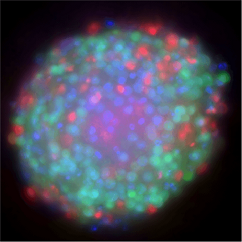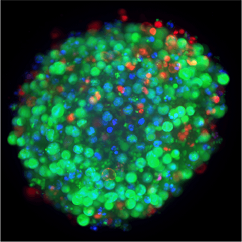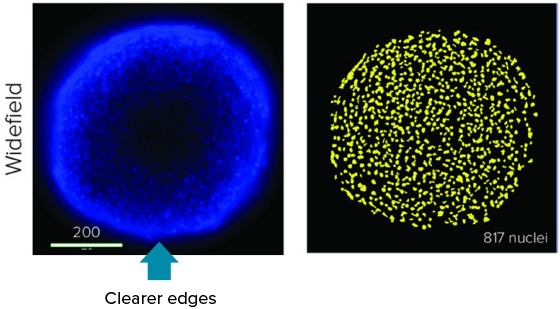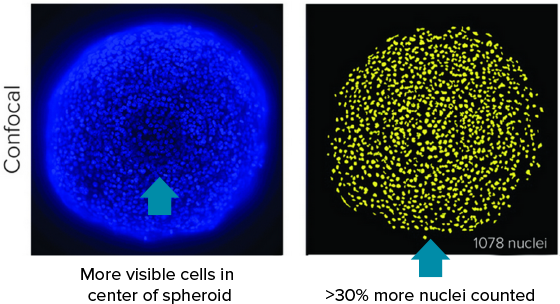
AgileOptix Spinning Disk Confocal Technology
Powerful solid-state light engine, custom optics, scientific CMOS sensor, and the ability to change between five different disk geometries
AgileOptix spinning disk confocal microscopy
Our proprietary AgileOptix™ Spinning Disk Technology is a microscopy innovation designed to run more complex, physiologically-relevant cellular models including 3D spheroids, tissues, live-cell assays, and whole organisms. This technology combines the clarity of confocal imaging with the throughput and flexibility of the ImageXpress® HCS.ai High-Content Screening System.
Unlike other spinning disk confocal technologies used for high-content screening, AgileOptix technology offers the ability to adapt disk geometries to meet your unique assay requirements. It is one of the few technologies on the market that includes a unique dual disk configuration with both pinholes or slits to accommodate high-throughput applications.

Widefield

Confocal
Multiple confocal disk configurations for optimized assay performance
AgileOptix Spinning Disk Technology includes simple, user-defined configurations to ensure maximum assay performance for both confocal and widefield imaging. Multiple confocal disk geometries are available including pinhole and slit configurations.
(single disk)
with 50 µm slit
with optimized
spacing geometry
*Powered by our highly responsive sCMOS sensor and advanced solid state light source.
60 µm dual disk with 42 µm pinhole pinhole size available with the ImageXpress® Micro Confocal and ImageXpress® Confocal HT.ai systems
How spinning disk confocal technology works
One aspect of AgileOptix technology is a spinning disk light path, which includes a very bright solid state light engine. Excitation light passes through a rapidly spinning disk with symmetrically placed spirals of pinholes or slits. These pinholes or slits split the illumination light into multiple beams that scan the fluorescent sample. Emission light from the sample then passes back through the confocal disk and is then directed via a dichroic beamsplitter through the emission filter to a high-sensitivity scientific CMOS camera.
Optimize out-of-focus light or “haze” that can skew image analysis
AgileOptix spinning disk technology optimized for high resolution, tissue penetrance, and high throughput


*Data and images were acquired using the ImageXpress Micro Confocal High-Content Imaging System during development using customer samples. Results may vary.
Deep tissue, confocal disk module
Specialized deep tissue penetrating, confocal disk module, combined with a laser light source, improves light penetrance for deeper tissue penetration, resulting in sharper images with improved resolution when imaging thick tissue samples. This disk option is available with the ImageXpress® HCS.ai Advanced High-Content Screening System.
- Improve suppression of out-of-focus light
- Reduce haze (pinhole crosstalk)
- Penetrate deeper into thick tissue samples for sharper images

Standard Spinning Disk

Deep Tissue Spinning Disk
Data and images were aquired using the ImageXpress® HCS.ai High-Content Screening System during development using customer samples. Results may vary.